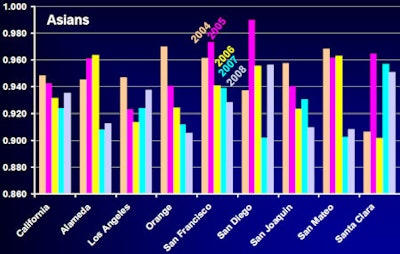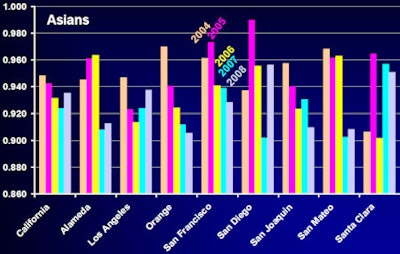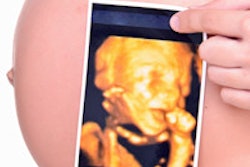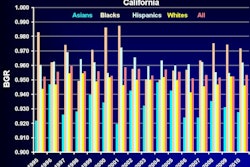
The use of ultrasound to enable gender-selective abortion has been associated with abnormally low female-to-male birth ratios in a number of Asian countries. But the proliferation of fetal keepsake ultrasound in the U.S. may be responsible for a similar trend in California among Asian communities.
That's according to a hypothesis presented on Saturday at the 2010 American Institute of Ultrasound in Medicine (AIUM) meeting in San Diego. Although research from Advanced Imaging Associates in Fremont, CA, has not yet shown direct evidence linking keepsake ultrasound with abnormally low female-to-male birth ratios among Asians in California, low ratios in recent years were found to correlate with growing access to 4D keepsake imaging.
"The temporal and spatial correlation between the prevalence of keepsake ultrasound centers and low birth-gender ratios in specific subpopulations in some counties suggest that fetal gender information provided by keepsake ultrasound centers may be used by parents in making gender-selective abortion decisions," said presenter G. Sharat Lin, Ph.D.
Some countries in Asia have abnormally low female-to-male ratios, including India (933 females/1,000 males in 2001) and China (940 females/1,000 males in 2000). In these countries (as well as in some smaller nations), cultural and social preferences for sons are amplified by strong family planning programs, Lin said.
"This is well known that [ultrasound has] led to gender-selective abortions in China, India, and other countries in Asia, leading to abnormally low [birth-gender ratios]," he said.
In China, gender-selective abortions are driven by the one-child policy; because sons carry the family name, the preference is for a son, Lin said.
"When these people immigrate to California, there's a reduced motivation for gender-selective abortion, but it's still there, particularly if they have a very small family," he said.
Gender-selective abortion in India is being driven by social pressures. Upon marriage, a woman joins the groom's family and may support her new family with any future earnings. In addition, the bride's family traditionally gives a dowry to the groom's family, Lin said.
"So these are motivations for gender-selective abortion that may or may not remain strong among immigrants," he said.
In California, keepsake ultrasound centers have become increasingly popular, thanks to the availability of increasingly powerful and less expensive 4D ultrasound systems. These centers have proliferated since 2000, and all emphasize fetal gender determination services in their marketing activities, according to Lin. The Asian population has also continued to increase in California.
Continuing his previous research to investigate the effects of commercial access to 4D ultrasound on birth-gender ratios in California, Lin computed birth-gender ratios from annual birth statistics obtained from the California Department of Public Health database by county, race, and gender of the child. He tabulated the findings for 1995-2008, and correlated the results with the growth and location of commercial keepsake ultrasound centers.
Female-to-male birth ratios for Asians in California ranged from 919 to 948 in the study period, consistently lower than the range of 951 to 960 for the general population in California and for all other racial categories, Lin said.
Ratios for Asians in Santa Clara County fluctuated significantly, ranging from 902 to 965. Three of the four lowest values for female-to-male birth ratios (< 910) took place in 2000 and afterward.
"That's an extremely low number," he said.
In concert with the growing number of keepsake ultrasound centers, Lin discovered an unprecedented number of low birth-gender ratios among Asians in other metropolitan areas in recent years, as indicated in the following table:
 |
| Y-axis: female-to-male ratio. X-axis: California counties. Image courtesy of G. Sharat Lin, Ph.D. |
In another trend, keepsake ultrasound centers have been sprouting up in areas away from the major cities, such as in Contra Costa County and into the San Joaquin Valley, according to Lin.
Lin said he interviewed some of the keepsake ultrasound centers in the San Joaquin Valley, and all said they receive clients from Bay Area cities. In addition, the launch of four centers in the San Joaquin Valley after 2004 has been followed by a precipitous drop in female-to-male birth ratios in San Joaquin County, Lin said.
In some good news, Lin did note a recent statistical rebound in Asian female-to-male birth ratios in Santa Clara County.
"In the metropolitan counties in the Bay Area, there is a lot of discussion about these issues, and there is probably a lot of social consciousness about the kind of decisions that prospective parents might make," he said. "So perhaps there are counterpressures to doing gender-selective abortions."
In future research activities, Lin plans to tabulate birth-gender data on specific Asian subgroups. "We're going to be working with the local public health officials to be gathering that data," he said.
By Erik L. Ridley
AuntMinnie.com staff writer
March 30, 2010
Related Reading
Connecticut bans keepsake US studies, July 29, 2009
Fetal entertainment ultrasounds draw patient interest, March 20, 2007
Controversy remains over keepsake prenatal ultrasound images, February 2, 2007
Fetal 4D US market grows despite FDA criticism, research finds, November 30, 2006
NJ lawmakers propose restriction on ultrasound sales, July 3, 2006
Copyright © 2010 AuntMinnie.com




















